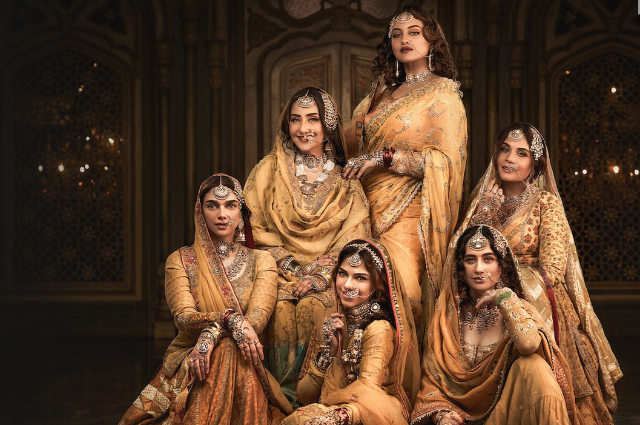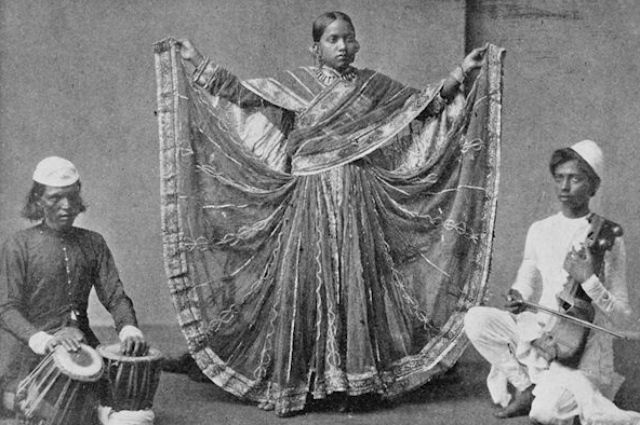“Why did you watch Heeramandi? Wo bhi koi dekhne ki cheez hai?”, (trans. Is it even worth watching?) This one question from my parents sums up how a culture once known for its finesse, elegance and epitome of etiquette is now lost to the confines of a world which is now domineered by Western influences. I believe they are not wrong. Our exposure to the tawaif culture and their way of life is mainly through their portrayal in popular Bollywood movies. And Heeramandi, a magnum opus directed and produced by Sanjay Leela Bhansali in his OTT directorial debut, is now added to that list. Oh, how do I start with it? Bhansali’s Heeramandi is a grandeur that is adorned with courtesans (a mega ensemble caste of the most prominent ladies of the Btown) decked in stunning textiles and jewellery along with, rich and sparkling architectural sets, symphonic gazal music, dialogues oh-so poetic that just pinches the right nerve and of course the allure of the lavish and larger-than-life filmmaking style that will enthral you to watch it.
Through the profession and beliefs of a tawaif, the dialogues of the show delve into the multifaceted world of human emotions including love, lust, anger, greed and more, that are often challenging or forbidden by societal norms.
I do understand that historical accuracy is liberally twisted for drama, glamour and modern aesthetics, but Heeramandi didn’t do justice to the exquisite tawaif culture that used to exist in the Indian subcontinent and was an essential part of it. With all eight courtesans having distinct personalities: manipulative, kind, shrewd, cunning, delusional, heartbroken, poetic, and rebellious, the show rather showed them as damsels in distress who were confined under the wraths of their own guilt and past but were also ridiculed publicly and lusted upon by their so-called patrons, the royal Nawabs. Further, even though the show sought to explore the role of tawaifs during the independence era, yet with its chaotic and extravagant storyline, the essence strayed, leading to a rushed and sketchy end. There is no denying that the show worked on dramatic dialogues and poetic demonstrations that had the potential to sometimes woo your heart or reignite your long-forgotten love for poetry. Some of my favourite dialogues that stuck a chord were, “ishq seekha nahi jata”, “julm karna aur sehna dono gunah hai”, “tawaif ruksat nahi aazad hoti hai”, “ hunar aur husn riyaz se nahi taqdeer se milte hai”. These dialogues somewhere explore the enduring power of human emotions. Through the profession and beliefs of a tawaif, the dialogues of the show delve into the multifaceted world of human emotions, including love, lust, anger, greed, and more, that are often challenging or forbidden by societal norms. Heeramandi embodied Bhansali's signature style: opulent period drama, star-crossed love, and a gothic portrayal of women yearning for freedom. The narrative unfolds with unexpected deaths and a seemingly deep appreciation for the courtesan culture of that era, just like the majority of his other works. Nevertheless, with overlapping storylines, the essence of the show was lost, and it merely reduced these courtesans to sex, glamour, and drama that somehow compromised the institution instead of flattering it.
I don’t want my article to be mistaken as a review of the show. When Heeramandi was just released, I scrolled through my Instagram and saw numerous reels and posts appreciating the concept and themes of the show. Some reels commended the real tawaif culture that was prevalent in the Indian subcontinent, and it made me want to dig deeper into it. Our tendency to focus on superficial similarities between this culture and prostitution has overshadowed the true depth and richness of traditional Indian culture. As Konkana Ray aptly writes in her text, "The Art of Tawaif: A Tradition Lost to Colonial Moralities", “The domain of the courtesan was an oasis of refinement, pleasure and contentment. The Tawaifs were known for their graciousness, refined customs, impeccable manners, and proficiency in dancing and singing, extending to sophisticated literary realms. Such was their influence on art and culture that they were considered to be authorities on tahzeeb or etiquette, so much so that the noble families would send their scions to them to learn the art of nafasat (refinement), nazakat (delicacy) and sharafat (decency).” Tawaifs were cultured, more than anyone else. They mastered presentation, demeanour and courtesy. Yet, the stereotype surrounding their profession that they were forced to become courtesans simply disregards their agency and willingness to choose their work and mocks the gravity of their art. During a time when societal expectations limited women to domestic roles, these remarkable women defied convention with their bold choices. They dedicated their lives to their art, forever changing the narrative for women.
During a time when societal expectations limited women to domestic roles, these remarkable women defied convention with their bold choices. They dedicated their lives to their art, forever changing the narrative for women.
Further, any sexual encounters were completely incidental and consensual, unlike those portrayed in several films and fictional works. Their royal patron didn’t come to them solely for sexual gratification; rather, they wanted to enjoy the rich and nuanced pieces of dance and literary recitations that augmented the quality of their entertainment. And as for financial aid, these tawaifs were well off which was eventually looted and captured by British officials. With colonial morals, everything was wiped out, including their dignity and artistic recognition. The colonial government categorised all the tawaifs, nautch girls (anglicised version of nach) and sex workers as “prostitutes”, thus making these female performers an outcast, someone who was supposedly ‘infiltrating’ the ideal social set-up and a threat to the moral health and well-being of Hindu society.
Further, these tawaifs were not merely entertainers, they were cultural advocates. They imparted their knowledge of poetry, dance and songs so that the royal court could thrive. However, with the rise of colonial rule, they were impoverished in terms of their status and work. Their conduct and flamboyant personalities, which were often scrutinized by the authorities, were just their way of life, promoting their art of courtship and seduction. The sheer indictment of their profession and stigmatizing sex has somehow led to an unhealthy portrayal of it in society. Ignoring the institution's complexities, British officials imposed their own interpretations, fundamentally altering its character, tainting it forever.
Art is the way of life, it has thrived cultural economies yet when artistic expression is stifled, it not only silences an artist but undermines the very foundation of a society that’s built on traditions and legacies. And as a fellow artist, I believe every work of art needs to be respected and acknowledged.
It’s ironic, though, that a country that’s known for its rich culture and traditions undervalues artistic pursuits. As a fellow artist, I have experienced it firsthand. Art is always debased; its purpose is questioned, and artists are always seen as wild wanderers. In a society that prioritizes practicality, artists are driven by their creative impulses. Their dedication to their craft surprises this world that focuses on tangibles. They are often questioned for their expression, just like these tawaifs. Art is the way of life; it has thrived in cultural economies, yet when artistic expression is stifled, it not only silences an artist but undermines the very foundation of a society that’s built on traditions and legacies. And as a fellow artist, I believe every work of art needs to be respected and acknowledged. Every art form possesses layers to be unravelled. This exploration fosters an appreciation for the artist's perspective and the beauty embedded within the work. By acknowledging the value art brings to individuals and society, we eliminate assumptions and avoid disrespecting artists and their professions. I agree that every art form loses its relevance with time yet it’s significant to acknowledge the contributions of all the stakeholders. Manjari Chaturvedi, the founder of The Courtesean Project, during her interview with The Quint, said “Hindi cinema and Bollywood are thanks to tawaifs. Their music, their dance, their stories, everything is a part of the Hindi cinema.” This statement is a testament to their legacy in Indian cinema and speaks volumes about their significance. And when Bollywood shows a flawed representation of it, it leaves bleak imprints in the minds of people. What is shown is what is perceived. Whatever little we know about this art form is through its representation in Indian cinema and predominantly Bollywood. Filmmakers, as artists, have a responsibility to present truthful representations of the cultures they depict, honouring them through accuracy rather than relying solely on imagination. I know that great artists don’t need anyone to rescue themselves; they live through their legacies. They navigated the changing times on their own terms, and these tawaifs were the embodiment of that. Yet if, only at individual levels, we make little effort to understand any art from beyond the surface, we can prevent countless artists, cultures, and societies from fading into obscurity.


